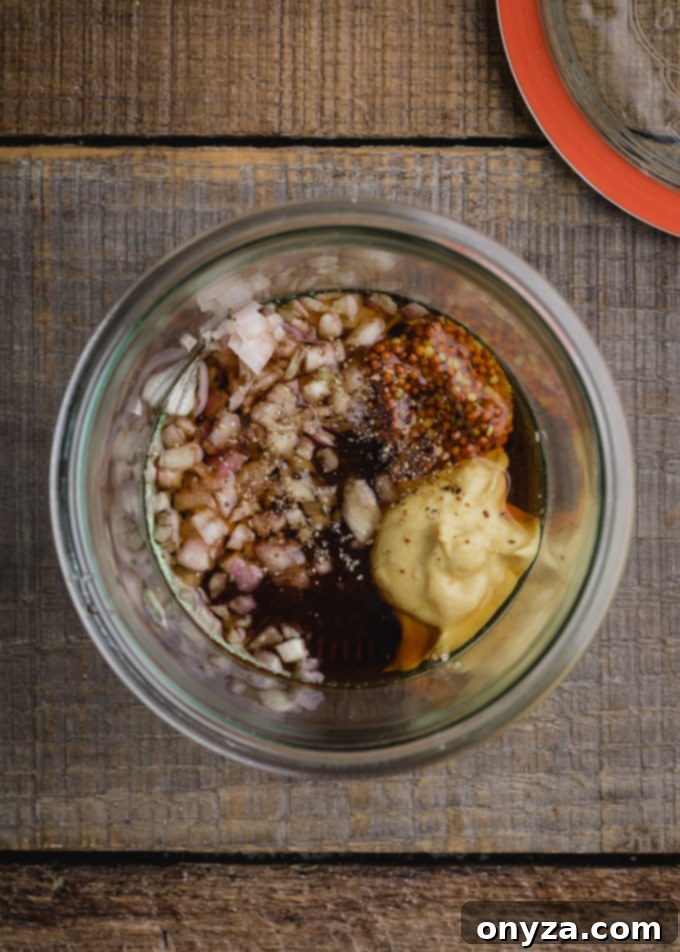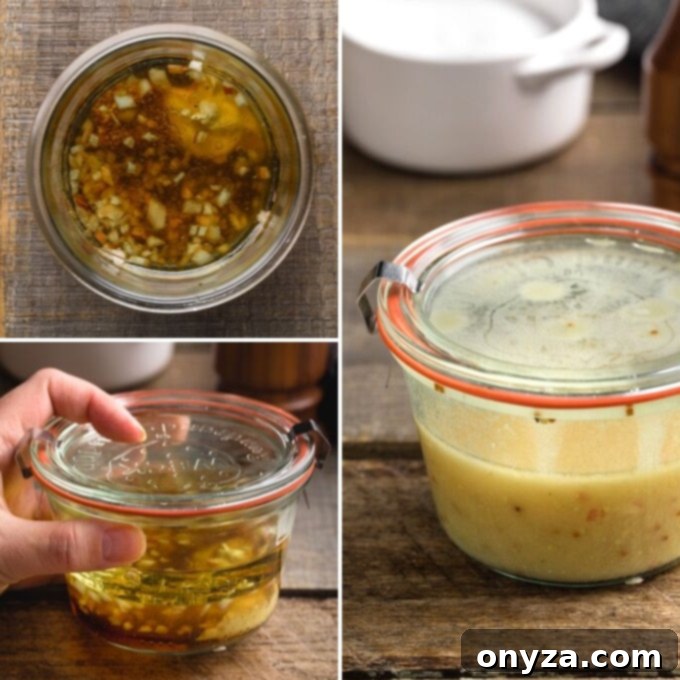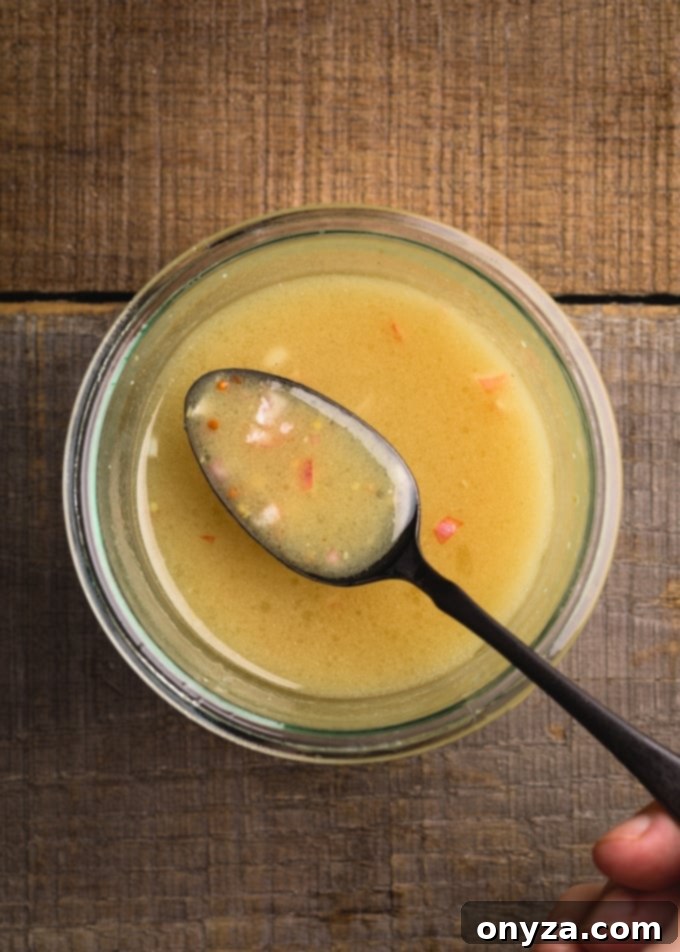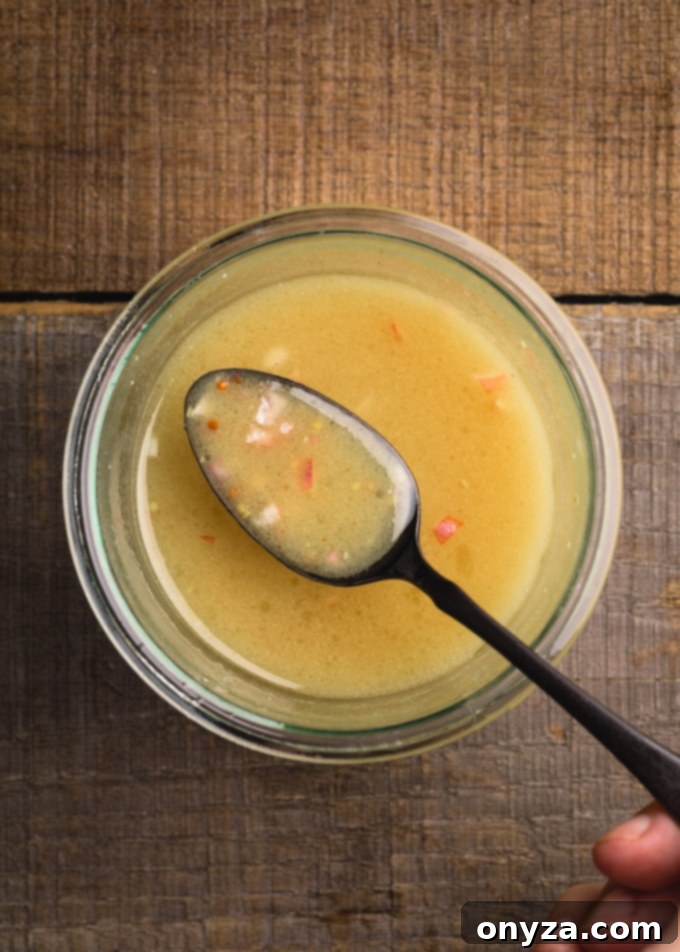Crafting a sensational salad dressing doesn’t have to be a chore. With just 5 minutes and a simple mason jar, you can prepare this exquisite Maple Vinaigrette. Infused with the sharp kick of Dijon mustard, the crisp tang of apple cider vinegar, and the delicate sweetness of shallots, this homemade salad dressing offers the perfect sweet-tangy finish for all your favorite fall greens and seasonal dishes. It’s an effortless way to elevate any meal from ordinary to extraordinary.

While spring and summer might traditionally steal the spotlight for vibrant salads, there’s an undeniable allure to the robust, crisp, and earthy flavors that autumn brings to the table. As the leaves begin to turn and the air cools, my cravings shift towards hearty ingredients like crisp apples, juicy pears, sturdy greens such as kale and spinach, and the rich, comforting sweetness of orange-fleshed squash and toasted pecans. These ingredients, with their deeper flavor profiles and satisfying textures, demand a dressing that can not only complement their richness but also tie them together with a touch of brightness and sophistication.
This is where the star of our show, Maple Vinaigrette, makes its grand entrance. This dressing isn’t just a recipe; it’s a culinary cornerstone for the fall season. It perfectly encapsulates the delicate balance between sweetness and tang that I seek during this time of year. Its ability to harmonize with both sweet and savory components of a fall salad makes it incredibly versatile. Furthermore, its ease of preparation is unmatched, making it an ideal choice for a quick lunch on the go or a delightful topping for an entree salad on a busy weeknight. Once you experience its magic, you’ll find yourself making this recipe on repeat all autumn long, discovering new ways to incorporate its delightful flavors into your meals.
Embracing homemade dressings like this Maple Vinaigrette is a game-changer for any home cook. Not only does it allow you to control the quality of your ingredients, but it also ensures a fresh, vibrant flavor profile that store-bought alternatives simply cannot match. This particular vinaigrette offers a unique blend that is both comforting and invigorating, promising to transform even the simplest salad into a memorable dining experience. Its smooth texture and perfectly balanced taste ensure that every bite of your salad is a delight, truly celebrating the bounty of the fall harvest.
The Essential Pantry Staples for Your Maple Vinaigrette
Crafting this quick and easy vinaigrette requires just a few readily available ingredients from your pantry. Each component plays a crucial role in achieving the dressing’s signature sweet and tangy profile.
- Pure Maple Syrup: The heart of our dressing, providing a rich, natural sweetness.
- Apple Cider Vinegar: Contributes a crisp, fruity tang that balances the maple’s sweetness.
- Smooth Dijon Mustard: Acts as a key emulsifier, helping to bind the oil and vinegar, while adding a zesty, sharp flavor.
- Coarse-Grain Dijon Mustard: Offers an additional layer of pungent flavor and a delightful textural contrast.
- Shallots (minced): Provides a delicate, aromatic onion flavor that is milder than traditional onions, enhancing the dressing’s complexity.
- Extra-virgin Olive Oil: The base of our vinaigrette, chosen for its smooth texture and rich, fruity notes.
- Kosher Salt and Freshly-Ground Black Pepper: Essential seasonings to heighten and balance all the other flavors.
The Unrivaled Quality of Pure Maple Syrup
For an unparalleled depth of flavor in this dressing, the choice of maple syrup is paramount. Always opt for pure maple syrup. Unlike pancake syrups, which are often composed primarily of high-fructose corn syrup and artificial maple extracts, pure maple syrup is a natural product derived directly from the sap of maple trees. This natural origin imparts a far more complex and nuanced flavor profile, featuring caramel notes and earthy undertones that artificial syrups simply cannot replicate. This richness is essential for the vinaigrette to stand up against its tangy components, creating a truly harmonious blend. Investing in a good quality pure maple syrup will make a significant difference in the final taste of your dressing.
Understanding Dijon Mustard: Smooth vs. Coarse-Grain
The combination of both smooth and coarse-grain Dijon mustard is one of the secrets to this vinaigrette’s success, adding both flavor and texture. Smooth Dijon mustard is a powerful emulsifier, helping the oil and vinegar to combine seamlessly into a creamy dressing. Its sharp, tangy profile cuts through the sweetness of the maple syrup, creating a vibrant balance. Coarse-grain mustard, on the other hand, contributes a wonderful texture with its visible mustard seeds, along with a slightly more robust and rustic flavor. This textural element adds an interesting dimension to the dressing, making each bite of salad more engaging. If you find yourself without coarse-grain Dijon mustard, you can easily adapt the recipe by omitting it and using an additional teaspoon of smooth Dijon instead. This adjustment would bring the total amount of smooth Dijon to 3 teaspoons, or 1 tablespoon, ensuring the dressing still achieves its desired tang and emulsification without compromising too much on flavor.
Curious to learn more about the distinct differences between pure maple syrup and its common imposters, like pancake syrup? Understanding these differences can significantly enhance your culinary endeavors. Discover the insights and knowledge you need in this informative article from Taste of Home.

Effortlessly Crafting Your Maple Vinaigrette
Preparing this exquisite dressing is incredibly simple, requiring minimal time and effort. You’ll need just 5 minutes of your time and a jar with a tightly-fitting lid, such as a standard mason jar. This method is perfect for anyone seeking a quick, delicious addition to their lunch or a speedy complement to a weeknight dinner.
The Speedy Jar Method
To create your Maple Vinaigrette using the jar method, simply gather all your ingredients and add them directly into the jar. Once everything is inside, secure the lid firmly and give it a vigorous shake. Continue to shake-shake-shake until you observe the dressing beginning to emulsify, meaning the oil and vinegar have combined into a cohesive mixture, resulting in a slightly thickened and creamy consistency. This method is not only fast but also minimizes cleanup, making it a favorite for busy individuals.
The Classic Bowl and Whisk Technique
Should you not have a jar readily available, or if you simply prefer a more traditional approach, making the dressing in a bowl is just as straightforward. When employing the bowl-and-whisk technique, a slight modification in the order of ingredients ensures optimal emulsification. Begin by combining all ingredients except for the olive oil in your bowl. Whisk these components together thoroughly. Then, while continuously whisking, slowly drizzle in the extra-virgin olive oil. This gradual addition, combined with steady whisking, allows the oil, vinegar, and mustard to emulsify beautifully, creating a stable vinaigrette that won’t separate quickly. This technique offers excellent control over the emulsification process, ensuring a smooth and consistent dressing every time.

Once your dressing is thoroughly mixed and appears creamy, take a moment to taste it. This is your opportunity to fine-tune the flavors to your personal preferences. You might find it needs an extra pinch of salt to brighten the overall taste, or perhaps a little more freshly-ground black pepper to add a gentle warmth and spice. Adjusting the seasoning to taste is a crucial step in creating a truly personalized dressing.
Customizing Sweetness and Tartness
The versatility of this Maple Vinaigrette truly shines when it comes to adjusting the balance of sweetness and tartness. This balance can be tailored not only to your personal palate but also to the specific salad you intend to serve. If you prefer a dressing with a more pronounced sweetness, simply add a bit more maple syrup and give the dressing another good shake or whisk. Conversely, for a sharper, more piquant dressing, an extra splash of apple cider vinegar will achieve the desired tang. Consider the other ingredients in your salad: if your salad features many sweet components like fresh berries or dried fruits, a slightly more acidic dressing might provide a welcome contrast. For salads with robust, savory elements like roasted vegetables or grilled meats, a touch more maple syrup can create a delightful harmony. This dressing recipe is remarkably adaptable, making it simple to adjust to your unique tastes and the specific needs of any dish.
Tips for Perfect Emulsification
Emulsification is the key to a smooth, uniform vinaigrette. Whether using the jar or whisk method, consistency is important. When whisking, a steady, thin stream of oil into the other ingredients while constantly mixing ensures tiny droplets of oil are suspended evenly throughout the vinegar, preventing separation. For the jar method, ensure all ingredients are at room temperature if possible, as cold oil can sometimes resist emulsifying. Vigorous shaking is crucial here – don’t be shy! If your dressing does separate after sitting, don’t worry, it’s natural. A quick re-shake or whisk will bring it back to its creamy, cohesive state.

Serving and Storing Your Maple Dijon Vinaigrette
Once mixed to perfection, your Maple Dijon Vinaigrette is ready to be enjoyed immediately on your favorite fall salads. Its unique sweet and tangy profile makes it an ideal complement to a wide array of seasonal ingredients. We particularly love it drizzled over a hearty Harvest Cobb Salad, where its flavors perfectly accentuate the diverse textures and components of the dish. Furthermore, if you’re looking to adapt other recipes, this maple vinaigrette makes an excellent vegetarian substitute. For instance, if preparing a Pear Salad and wishing to omit the bacon, this dressing provides a superb alternative, adding a vibrant sweetness and tang that enhances the pears beautifully.
Versatile Pairings for Every Occasion
The versatility of this dressing extends far beyond traditional salads. Consider using it as a marinade for grilled chicken or pork, adding a delightful caramelized crust and tenderizing effect. Drizzle it over roasted vegetables such as butternut squash, Brussels sprouts, or sweet potatoes to elevate their natural sweetness. It can also be a fantastic finishing touch for grain bowls featuring quinoa or farro, or even as a light sauce for pan-seared salmon. Don’t limit its use to just dinner; a dash of this vinaigrette can brighten up a simple lunch wrap or sandwich, making it a truly indispensable condiment in your kitchen.
Optimal Storage for Freshness and Longevity
If you find yourself with leftover vinaigrette after dressing your salad, or if you proactively decided to double the recipe for convenient meal prep throughout the week, rest assured that this dressing stores exceptionally well. When refrigerated in a tightly-covered container, it maintains its freshness and vibrant flavor for 5 to 7 days. This extended shelf life makes it an excellent option for preparing ahead of time, ensuring you always have a delicious homemade dressing ready to go.
Pro Tip for Storage: It’s entirely natural for homemade vinaigrettes to separate as they sit in the refrigerator. This occurs because oil and vinegar are immiscible liquids. However, this is easily remedied. Before each use, simply give the dressing a vigorous re-shake or whisk. The vinaigrette will quickly re-emulsify, returning to its slightly thicker, creamy, and uniform consistency, ready to perfectly dress your next dish.
The Benefits of Homemade Dressings
Choosing to make your own salad dressings, like this Maple Vinaigrette, offers numerous advantages over store-bought alternatives. Firstly, you have complete control over the ingredients, allowing you to select high-quality oils, fresh produce, and natural sweeteners, avoiding artificial flavors, preservatives, and excessive sodium often found in commercial dressings. Secondly, homemade dressings are typically more cost-effective. The basic ingredients are usually pantry staples, making it an economical choice in the long run. Lastly, there’s an unparalleled freshness and vibrancy to homemade dressings that elevates any meal. The ability to customize the flavor profile to your exact liking means your dressing will always perfectly complement your dish, offering a culinary experience that is both healthier and more satisfying.
This Maple Dijon Vinaigrette is more than just a dressing; it’s an invitation to explore the delicious possibilities of fall cuisine with ease and confidence. Its simple preparation belies its complex, satisfying flavor, making it a staple you’ll reach for again and again.
Maple Vinaigrette with Dijon Recipe
This sweet-tangy Maple-Dijon Vinaigrette is a delicious way to dress fall salads. Plus, it takes just 5 minutes to make!
Recipe Details
- Author: Amanda Biddle
- Prep Time: 5 minutes
- Total Time: 5 minutes
- Servings: 4 servings
Ingredients
- 1 tablespoon finely-minced shallot
- 2 teaspoons smooth Dijon mustard
- 1 teaspoon coarse-grain Dijon mustard
- 3 tablespoons apple cider vinegar
- 2 tablespoons maple syrup
- ⅓ cup extra-virgin olive oil
- kosher salt and freshly-ground black pepper, to taste
Instructions
- Add all ingredients to a mason jar with a tight-fitting lid, along with a pinch each of salt and pepper. Secure the lid and shake vigorously until the dressing is slightly thickened and creamy looking (emulsified).
- Taste the vinaigrette and season with additional salt and pepper, if needed. You can also adjust the flavor profile, to taste, by adding an additional splash of maple syrup for a sweeter dressing, or apple cider vinegar for more tang.
- Use immediately or refrigerate, covered, for up to a week. Dressing will separate as it sits; shake well before using.
Notes
Alternatively, you can make the dressing in a bowl. Stir together all ingredients except for the olive oil. Whisk in the oil in a steady stream until the dressing is emulsified. Season to taste and serve.
Nutrition Estimate
Calories: 193kcal | Carbohydrates: 7g | Protein: 1g | Fat: 18g | Saturated Fat: 2g | Sodium: 45mg | Potassium: 23mg | Fiber: 1g | Sugar: 6g | Calcium: 11mg | Iron: 1mg
Nutrition information is automatically calculated, so should only be used as an approximation.
About Our Recipes: Please note that our recipes have been developed using the US Customary measurement system and have not been tested for high altitude/elevation cooking and baking.
